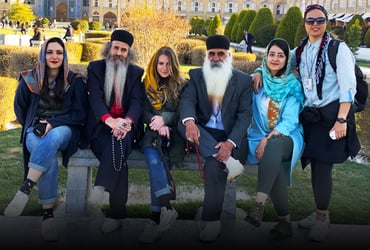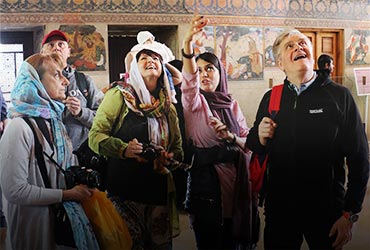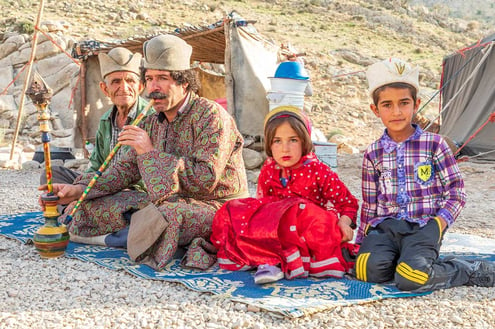Iran Travel FAQ: Common Questions Answered
Get all the answers to your questions about traveling to Iran on our FAQ page. Learn essential travel tips, discover the top destinations, and find out how to stay safe while exploring the country’s rich culture and history. Plan your trip to Iran with ease and confidence.
When is the best time to visit Iran?
The best time to visit Iran depends on what type of climate and activities you prefer. The spring (mid-March to May) and fall (September to mid-November) are generally considered the best times to visit as the weather is mild and comfortable, perfect for sightseeing and outdoor activities.
The summer months (June to August) can be very hot, especially in the desert regions, and the winter (December to mid-March) can be quite cold in the mountainous areas.
Events
Prior to traveling to Iran, you should take note of a few events.
Nowruz (Iranian New Year): Nowruz is in the first days of spring, is the most crowded and many tourist places and hotels have a high occupancy rate.
Ramadan: Ramadan can be a good time to visit Iran if you are interested in experiencing the culture and traditions of the country and don’t mind the restrictions on food and drink during the day.
Ashura: Travel to Iran during Ashura and Muharram can be a truly extraordinary experience and a perfect time to see the most important events of Shia in Iran.
Do I need a visa to travel to Iran?
An Iran tourist visa is issued in case you wish to travel to Iran for tourist purposes only. Almost everyone needs a visa to enter Iran, unless you have a Turkey, Armenia, Azerbaijan, Bolivia, Georgia, Malaysia, Syria and Venezuela passport in which case they’ll just stamp you in at the border. Read more…
Are credit cards accepted widely in Iran?
Due to the imposition of financial sanctions international credit cards are not currently accepted in Iran. It is advised for travelers to bring cash with them.
Which is the best city in Iran to visit?
The classic route of Iran goes right into the heart of the country. The four major cities along this route include Tehran, Isfahan, Yazd, and Shiraz. Read more…
Is it safe to travel to Iran now?
Despite the engineered picture projected in the mainstream media, Iran has always been safe for tourists. Read more…
Can you travel to Iran as an unmarried couple?
Yes! This is an often more assumed problem than a real one for most travelers. Traveling to Iran will not be a problem.
Can I use my cell phone in Iran?
Contact your cellular telephone provider to determine if your phone operates on the Global System for Mobile Communications (GSM) and what, if any, activation may be required.
Is there Internet access in Iran?
Yes, there is Internet access everywhere! In hotels, coffee shops, and most restaurants, you will have no problem accessing Wi-Fi, and some carriers offer decent 4G Internet. It may be spotty sometimes, but it will work! If all else fails, never fear! Internet cafes are an inexpensive alternative way to connect with the world.
How can I get travel insurance coverage in Iran?
As of May 21, 2024, it is required to purchase Iranian travel insurance when applying for a visa at an Iranian embassy or upon arrival at the airport. The insurance costs €10 per person and must be paid directly when receiving the visa paper at the Iranian consulate or upon arrival at the airport.
Important Note: Please ensure you have cash available to cover this expense.
Is it safe for women to visit Iran?
All women are required to follow the dress codes prescribed for women while traveling in Iran. It means wearing a headscarf and not allowing the skins on your arm or legs to be shown while in public.
Is it safe for US citizens to visit Iran?
US citizens will have to have their itinerary and tour guide approved beforehand. Sticking to the itinerary is part of the conditions of visa approval, so sticking to the itinerary and instructions of the tour guide will ensure there are no problems. The Iranian government is highly sensitive for historical and political reasons about any foreign involvement in the political process, in particular, this applies to the United States. Avoiding political demonstrations and making public political statements is another way to avoid trouble.
Otherwise, Iranians will be keen to demonstrate their hospitality to US citizens and offer to host them for lunch or dinner. Hostility towards particular actions of the US government doesn’t stop the people of Iran from having nothing but the warmest feelings for Americans themselves.
Can I travel independently to Iran? Do I need a guide to travel to Iran?
Most people can travel independently inside Iran without any guide or specific official guidance. US and Canadian citizens, however, need to have their itinerary and tour group approved beforehand, which will require an officially sanctioned guide.
Many people, however, prefer to go on guided tours, as much of the population, including those who work in tourism, do not have proficiency in English, making some experiences more difficult.
Can I drink alcohol in Iran?
Drinking alcohol is against the law in Iran, and no shops are permitted to sell it. Anyone caught in possession of alcohol faces arrest, and in that case, a tourist will face deportation. People in Iran tend to drink tea, Sharbat (a cool, sweet drink known as the world’s first soft drink), or Doogh (a savory yogurt drink). Alcohol-free beer is also available.
Is it permitted to take photos of historical sites and people in Iran?
Rules on photography depend on the place. Many mosques will allow photography inside and outside. Some museums will not allow photography inside but only outside. Generally, if it is not permitted, a sign will indicate it. Restrictions are placed on photography of government and military buildings. For ordinary people, when taking photos of a specific person, it is always better to ask for permission. Often this will lead to a positive response as many Iranians like to pose for photos.
Can I buy souvenirs like Persian rugs in Iran?
Yes, it is possible to buy Persian rugs or other souvenirs. Iran is known for having the best rugs and carpets in the world. However, be careful before spending lots of money to make sure of getting a genuine item rather than a fake. When buying items in places like the Bazaar, bargaining for the price is considered normal.
How is the climate in Iran?
Iran has a hot, dry climate characterized by long, hot, dry summers and short, cool winters. January is the coldest, and August is the hottest month of the year. A&K’s programs travel during the spring and fall when temperatures are moderate. Average temperatures range between the low 50s°F at night to the upper 80s°F during the day.
What to wear in Iran in winter?
Considering that January to March experiences maximum winters in Iran, it provides for enough dresses. Overcoats, mufflers, gloves, and warmers might be the thing for you. You can wear leather boots too. Shawls, warm sweatshirts, and woolen caps can make you look dressy and bright at the same time.
Tours & Activities Hand-picked By Local Experts
Personalize your itinerary
Talk with a SURFIRAN travel specialist who can help organize your trip.




 SURFIRAN
SURFIRAN






WhatsApp: +98 912 880 3921